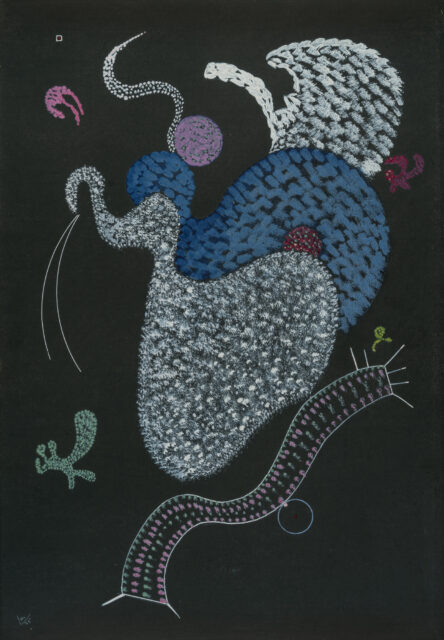“Pointillé”
Details
With various hand-written and stamped numbers on the reverse, French customs stamps and labels. House catalogue of the artist, V, 1935, no. 559; Barnett 1188. Literature: Kandinsky, Wassily, Toile Vide, etc., in: Zervos, Christian (ed.), Cahiers d’Art, 5-6, Paris 1935, p. 118, with ill. Exhibitions: W. Kandinsky: nouvelles toiles, aquarelles, dessins, Galerie Cahiers d’Art, Paris 1935, no catalogue;The Fifteenth International Exhibition of Watercolours, The Chicago Art Institute, Chicago 1936, cat. no.120, with ill. with label on the reverse;Contemporary German Art, The Institute of Modern Art, Boston 1939, cat. no.24, with ill. with label on the reverse; Soutine, Kisling, Utrillo e la Parigi di Montparnasse, Farsetti Arte, Cortina d’Ampezzo 2003/04, cat. no.22, with col. illus. p. 65.Provenance: collection of I. B. Newman, New York, since November 1935; Nierendorf Gallery, New York, since July 1942, with label on the reverse (no. 206); Solomon R. Guggenheim Museum, New York, with label on the reverse and stamped twice with the number “983”, acquired from the aforementioned in 1945, relinquished 1971; Parke-Bernet Galleries Inc., New York 20.10.1971, lot 55; collection of Jerome L. Greene (1906-1999), New York,acquired from the aforementioned; Jewish Museum, New York, gifted from the estate of the aforementioned, relinquished 2000; Sotheby’s, New York 11.5.2000, lot 224; Farsetti Arte, Prato 26.5.2001, lot 504; Farsetti Arte, Prato 1.12.2007, lot 721; private collection, Monaco.
Description
• Characteristic gouache on black card from Kandinsky’s late period
• The soft, organic forms reflect Kandinsky’s interest in the emerging field of molecular biology in the 1930s, which was encorporated into his abstract formal vocabulary
• Works from this time are quintessential of his decades-long artistic development
“To be able to devote oneself [to art], one must be a good draughtsman, have a great sensitivity for composition and colour and, above all, be a true poet.” Kandinsky, 1931
The work “Pointillé” belongs to a group of gouaches on black paper that Kandinsky painted in France in the last decade of his life. They were created at the height of his career and bear witness to the virtuosity of his mature style. After the final closure of the Bauhaus in 1933, Kandinsky left Germany and moved to Neuilly-sur-Seine near Paris with his wife Nina. In the years that followed, he rarely painted on canvas, favouring paper instead. For him, these works on paper are accomplished, independent works that bear all the hallmarks of his individual style. The technique of applying bright pigments to dark paper refers back to Kandinsky’s artistic beginnings at the height of the Art Nouveau movement around 1900. Even then, Kandinsky preferred to use coloured, black or brown paper for his stylised and decorative motifs. The biomorphic forms of “Pointillé”, which can also be found in comparable works from this period, are a clear departure by Kandinsky from the geometric, linear compositions of his Bauhaus years. Instead, surrealist influences and an examination of the formal aesthetics of Jean Arp and Joan Miró can be recognised here, with whose art Kandinsky came into closer contact in Paris in the 1930s – even if he did not feel attracted to the surrealist preoccupation with the unconscious and dreams. These softer, more organic forms were certainly also influenced by Kandinsky’s interest in molecular biology in the 1930s, as evidenced by a collection of magazine and newspaper cuttings that the artist kept on this subject. Another source of inspiration for his new aesthetic was probably Ernst Heinrich Haeckel’s book “Kunstformen der Natur” (Art Forms of Nature), which contained over 100 illustrated plates and was first published as a complete edition in 1904. Many of the forms that can be found in Kandinsky’s late work from the last decade of his life are similar to the micro- and deep-sea organisms depicted there. The luminosity that Kandinsky creates through the use of colored or white gouache on black paper and the sometimes surprising playfulness of the motifs obscure the great discomfort and distress that Kandinsky was experiencing during this time. Kandinsky, now almost 70 years old, found it difficult to gain a foothold in France, where abstract art found little recognition in Paris, which was dominated by Cubism and Surrealism. Only the gallerists Jeanne Bucher and Christian and Yvonne Zervos with their gallery and art magazine “Cahiers d’Art” supported him. Nevertheless, Kandinsky worked with enormous vigour and created a late work of great poetry and clarity that represents the quintessence of his decades-long artistic development.
* All results incl. buyer’s premium (27%) without VAT. No guarantee, subject to error.
** All post-auction prices excl. buyer's premium and VAT. No guarantee, subject to error.
*** Conditional Sale: The bid was accepted below the limit. Acquisition of the work may still be possible in our post-auction sale.
R = regular taxation
N = differential taxation on works of art which originate from a country outside of the EU
The private or commercial use of images shown on this Website, in particular through duplication or dissemination, is not permitted. All rights reserved.


